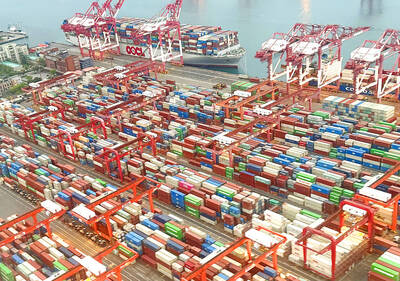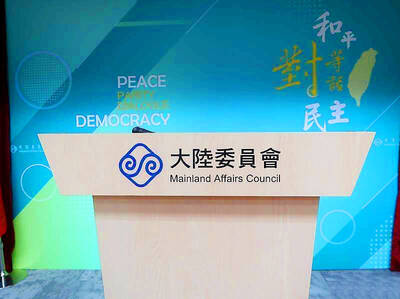Amazed by the beauty of puppet theater, Dutchman Robin Ruizendaal has devoted himself to studying Asian — particularly Taiwanese — puppet theater and is now the director of the Lin Liu-hsin Puppet Theatre Museum in Taipei.
“I’ve always been interested in drama in general since I was little. I wrote scripts and directed some plays when I was a university student,” Ruizendaal said in Mandarin during an interview on Sept. 4 in his office at the museum.
Surrounding him were shelves of books on puppet theater, the making of puppets, drama, posters featuring puppet theater performances from different parts of the world, trophies, certificates of gratitude — and a few puppets.
“So, I’ve read about puppet theater in Asia long ago in books, but when I saw real-life performances in China’s Fujian Province, I was totally amazed and overwhelmed by its beauty,” he said.
Having received a master’s degree in Sinology in his native Netherlands, Ruizendaal went on to study Chinese at Xiamen University in China in 1986.
It was in Xiamen that Ruizendaal first saw live performances of Hokkien puppet theater, which is a close relative of Taiwan’s budaixi (布袋戲).
Bringing home with him the interest he developed for puppet theater in China, Ruizendaal returned in 1991 to the Netherlands where he entered the doctoral program at Leiden University and specialized in Chinese marionette theater.
“Actually, besides being amazed by puppet theater performances, a key reason that motivated me to study puppet theater is that there was not a lot of research done in the area,” Ruizendaal said. “Most people like operas, musicals and dramas, but not so much puppet theater, so I consider puppet theater a minority culture, and I always care more about minority cultures.”
Although he made most of his discoveries about puppet theater in China, life brought him back across the Taiwan Strait to the country he visited for a few months in 1991.
“I came to Taiwan in 1993 originally to help organize a puppet theater festival,” but ended up staying in the country, Ruizendaal said.
Today, Ruizendaal is the head of a leading puppet theater museum in Taiwan and its puppet theater troupe.
The museum is suitably located on the west end of Taipei in an area known as Dadaocheng (大稻埕).
With its harbor on the bank of the Tamsui River (淡水河), Dadaocheng was a busy trading port during the Qing Dynasty and Japanese colonial period.
A centuries-old temple and a busy commercial street with storefronts and houses of the country’s leading traders — built during the Japanese colonial period — are found near the museum, which was founded to preserve the puppet theater culture.
“We keep over 8,000 items relating to puppet theater in the museum. Some of the puppets in our museum are over a hundred years old,” Ruizendaal said.
“We often go to antique shops searching for puppets, and, as we’ve established our reputation, some antique dealers would come to us when they acquire antique puppets,” he said.
In fact, the museum is more than just a museum; it also has a troupe that performs Taiwanese budaixi around the world.
“We’ve been to Europe, North and Latin America and neighboring Asian countries to perform — in fact, we will be representing Taipei in a performance art festival in Seoul, South Korea,” Ruizendaal said. “Such tours are great opportunities for us to exchange puppets with troupes in other countries and expand our collection.”
Besides performances by the museum’s troupe, it often invites other professional troupes to perform at the museum.
“On every Saturday this month, we have puppet masters from the well-respected Xiaoxiyuan (小西園) troupe to show off their amazing skill in performing kung-fu scenes with glove puppets,” he said.
The museum also makes their own puppets.
On the second floor of the museum’s office, there is a room with a table on which the museum’s own craftsman works on the heads of puppets.
Traditional Taiwanese budaixi glove puppets consist of a body made with cloth, while the head, hands and feet are made with wood.
“Here’s an unfinished head of [Frederic] Chopin — we’re invited to perform a story of Chopin with puppet glove,” Ruizendaal said, holding an unfinished and uncolored wooden figure.
On the table, there were several print-out portraits of Chopin.
In another small room on the left of the visitor’s entrance to the museum, several people were busy working on puppets’ clothes using a tailor machine, scissors and sewing needles.
“I would call this an amazing success,” Ruizendaal said.
“It’s a success, but it would’ve been perfect if we were not always short of funds,” he said, laughing.
At the moment, the museum runs on income from ticket sales and performances, government subsidies and corporate sponsorship.
“Corporate sponsorship is a big part of our income because we don’t have that many visitors, and cultural organizations like us seem to be less favored by the government,” he said. “But in any case, I think puppet theater in Taiwan has passed the endangered phase, and the development is somewhat stable now.”

MORE VISITORS: The Tourism Administration said that it is seeing positive prospects in its efforts to expand the tourism market in North America and Europe Taiwan has been ranked as the cheapest place in the world to travel to this year, based on a list recommended by NerdWallet. The San Francisco-based personal finance company said that Taiwan topped the list of 16 nations it chose for budget travelers because US tourists do not need visas and travelers can easily have a good meal for less than US$10. A bus ride in Taipei costs just under US$0.50, while subway rides start at US$0.60, the firm said, adding that public transportation in Taiwan is easy to navigate. The firm also called Taiwan a “food lover’s paradise,” citing inexpensive breakfast stalls

TRADE: A mandatory declaration of origin for manufactured goods bound for the US is to take effect on May 7 to block China from exploiting Taiwan’s trade channels All products manufactured in Taiwan and exported to the US must include a signed declaration of origin starting on May 7, the Bureau of Foreign Trade announced yesterday. US President Donald Trump on April 2 imposed a 32 percent tariff on imports from Taiwan, but one week later announced a 90-day pause on its implementation. However, a universal 10 percent tariff was immediately applied to most imports from around the world. On April 12, the Trump administration further exempted computers, smartphones and semiconductors from the new tariffs. In response, President William Lai’s (賴清德) administration has introduced a series of countermeasures to support affected

CROSS-STRAIT: The vast majority of Taiwanese support maintaining the ‘status quo,’ while concern is rising about Beijing’s influence operations More than eight out of 10 Taiwanese reject Beijing’s “one country, two systems” framework for cross-strait relations, according to a survey released by the Mainland Affairs Council (MAC) on Thursday. The MAC’s latest quarterly survey found that 84.4 percent of respondents opposed Beijing’s “one country, two systems” formula for handling cross-strait relations — a figure consistent with past polling. Over the past three years, opposition to the framework has remained high, ranging from a low of 83.6 percent in April 2023 to a peak of 89.6 percent in April last year. In the most recent poll, 82.5 percent also rejected China’s

PLUGGING HOLES: The amendments would bring the legislation in line with systems found in other countries such as Japan and the US, Legislator Chen Kuan-ting said Democratic Progressive Party (DPP) Legislator Chen Kuan-ting (陳冠廷) has proposed amending national security legislation amid a spate of espionage cases. Potential gaps in security vetting procedures for personnel with access to sensitive information prompted him to propose the amendments, which would introduce changes to Article 14 of the Classified National Security Information Protection Act (國家機密保護法), Chen said yesterday. The proposal, which aims to enhance interagency vetting procedures and reduce the risk of classified information leaks, would establish a comprehensive security clearance system in Taiwan, he said. The amendment would require character and loyalty checks for civil servants and intelligence personnel prior to